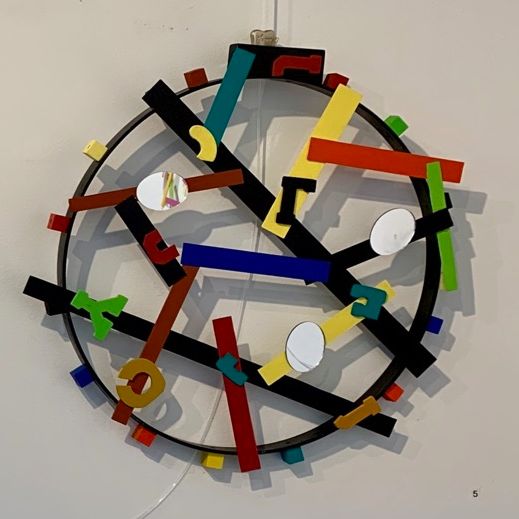"Abby Wasserman: Mixed-media Constructions" Essay by Allison M. Moore, Ph.D.

Exhibit Essay by Allison M. Moore, Ph.D.
In 2003, a year after her solo watercolor show in O’Hanlon Gallery, Abby Wasserman turned toward three dimensional art, making wall reliefs and sculptures as assemblages of found and gathered natural materials imbued with personal connections. Recent works continue a lifelong interest in autobiography and family biographies in an abstract mode, bringing a new aesthetic in her work influenced by her interest in Zen Buddhism, in which practice she has been involved for nearly a decade.
Abby has always been fascinated with Japanese culture. Growing up in Mill Valley, she was surrounded by her mother’s Japanese tansu and porcelain, which influenced her striking assemblages of found and upcycled materials. Her sculptures and wall reliefs suggest ideas of balance, musicality and harmony. Abby lived abroad with her first husband and young sons in countries where she was not fluent in the local language, including Turkey and Nigeria, although she learned well enough to communicate daily expediencies and pleasantries. She uses fragments of Japanese calligraphy decoratively in numerous works, such as Bird Zendo, to suggest the mysteries contained in an unfamiliar language that is beautifully written. Calligraphy that appears in Shrine I and Her Whole Life Flashes Before Her Eyes was salvaged from a Japanese lantern belonging to her husband Potter’s family, who lived several years in post-war Japan.
A number of works play with balance through asymmetry in the inner space of the circle, or use the circle as an element in a larger composition. The embroidery hoop is often the starting point for her works. The hoop’s slight wooden frame and circular shape bring to mind the enso, or Zen circle drawing, offering a sense of unity and wholeness that Abby complicates, sometimes through visual fragmentation of the circle, as in Dharma Ladder, and sometimes through additions that create patterns with negative space, such as in Homage to Dogen Zenji (a tribute to the Zen philosopher-poet) and California Blue Bar Clock. A strong maternal ethos also pervades these works, as Abby is also a mother and grandmother. Harmony through asymmetry, an original ideal of De Stijl modernism, seems relevant to motherhood and to a long and rich, fulfilling life.
Abby is attracted to Japanese art because of its perfectionism and high element of craft, yet she is especially drawn to the Japanese concept of wabi sabi, an aesthetic of imperfection and transience that permeates many of her works, expressed through fragile materials such as a rodent skull, wicker, horsehair, willow twigs, pine needles, feathers, shells, and in Bird Ryokan, a bird’s nest. Her use of wishbones suggests chance and also the eminently human circumstance of hope or optimism, choices not made or paths dangling and perhaps not taken. Homey materials such as buttons and thread spools add domestic flare to work that often seems about the difficulties of communication as well as overcoming those difficulties through an abstract yet ultimately harmonious composition. Mirrors are placed to reflect parts of a composition back on itself, or to bring the viewer inside for a passing moment.
Abby’s art seems to imagine the infusion of Japan on California culture. She is highly interested in Plains Indian cultures, which she originally learned about from her maternal grandfather’s studies. She also acknowledges the importance to her of sculptor Martin Puryear and of Noah Purifoy, with whom she became friendly in the 1990s when she worked at the Oakland Museum. Recent works incorporate bright color and musical notes, the former influenced by Frank Stella, the latter by her involvement in classical music. Most importantly, perhaps, was her life-long close relationship to the California sculptor and ceramic artist Mary Lindheim, a close friend of Abby’s parents, who actively modeled the role of a fearless woman artist and incorporated patterns of stones into her late wall reliefs. Abby’s War Machine, an assemblage of wood, straw and glass that addresses the victims of war, is dedicated to Lindheim, an anti-war activist.
Another freestanding piece, Radio Waves, highlights Abby’s incorporation of change and flexibility into her artworks. Created some four years ago and painted for this exhibit, its bright copper grille, radiating different lengths of twigs, its “mouth” a bit awry, suggests the importance of radio in Abby’s childhood, and its recent re-incorporation in the sense of podcasts. Like that older technology recently reactivated, Abby’s artworks play in the space between past and present modes, inviting the viewer to look closely and appreciate careful transitions between color and texture, negative space and form, while appreciating the overall work as they protrude gracefully from the wall like shrine symbols or hanging prayer forms.
Allison M. Moore is an art historian based in Tampa, Florida.